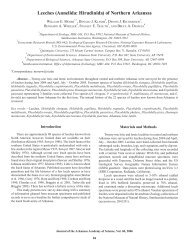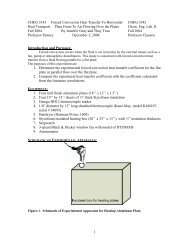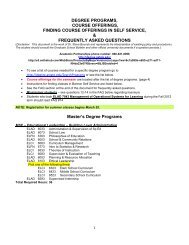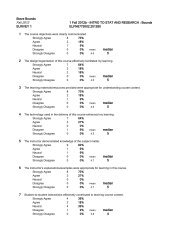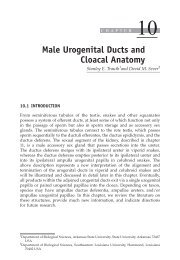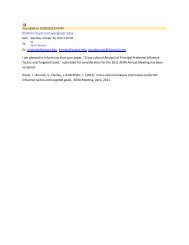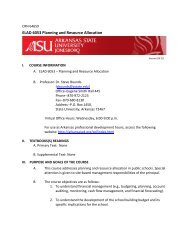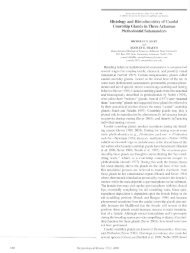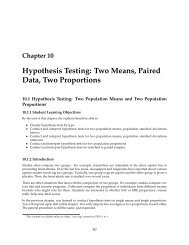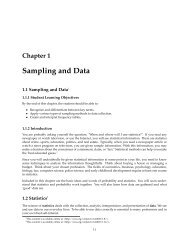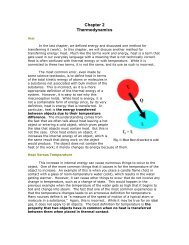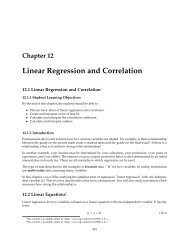Morphology of the spermatozoa of the iguanian lizards ...
Morphology of the spermatozoa of the iguanian lizards ...
Morphology of the spermatozoa of the iguanian lizards ...
You also want an ePaper? Increase the reach of your titles
YUMPU automatically turns print PDFs into web optimized ePapers that Google loves.
l. _ /&;;z<br />
]. SUBMICROSC. CYTOL. PATHOL., 32 (2), 261-271, 2000<br />
.. ;'.<br />
<strong>Morphology</strong> <strong>of</strong> <strong>the</strong> <strong>spermatozoa</strong> <strong>of</strong> <strong>the</strong> <strong>iguanian</strong> <strong>lizards</strong><br />
Uta stansburiana and Urosaurus ornatus (Squamata,<br />
Phrynosomatidae)<br />
D.M. SCHELTINGA, B.G.M. JAMIESON, S.E. TRAUTH' and C.T. MCALLISTER"<br />
Department <strong>of</strong> Zoology and Entomology, University <strong>of</strong> Queensland, Brisbane, Qld, Australia; 'Department <strong>of</strong> Biological Sciences, Arkansas<br />
State University, AR, USA; "Natural Sciences Department, Tarrant County College-South Campus, Fort Worth, TX, USA<br />
SUMMARY - The <strong>spermatozoa</strong> <strong>of</strong> Uta stansburiana and Urosaurns ornatus show <strong>the</strong> following squamate autapomorphies:<br />
a single perforatorium extending anteriorly from <strong>the</strong> apical tip <strong>of</strong> <strong>the</strong> paracrystalline subacrosomal cone;<br />
<strong>the</strong> presence <strong>of</strong> an epinucleat electron lucent region; intermitochondrial dense bodies; and <strong>the</strong> fibrous sheath<br />
extending into <strong>the</strong> midpiece. The acrosome vesicle is flattened and concentrically zoned apically; basally it overlies<br />
a subacrosomal cone which invests <strong>the</strong> nuclear rostrum. A stopper-like perforatorial base plate, rounded nuclear<br />
shoulders and a basal nuclear fossa are present. The proximal centriole contains a density within its centre for<br />
approximately one half its length and lies at approximately 80 0 to <strong>the</strong> distal centriole. The two central singlets <strong>of</strong><br />
<strong>the</strong> axoneme extend into <strong>the</strong> short distal centriole. A peripheral dense fibre is associated with each <strong>of</strong> <strong>the</strong> nine<br />
triplets <strong>of</strong> <strong>the</strong> distal centriole, and <strong>the</strong> fibre continues posteriorly with each <strong>of</strong> <strong>the</strong> nine doublets <strong>of</strong> <strong>the</strong> axoneme. A<br />
central fibre is associated with <strong>the</strong> tWo central singlets. AJl fibres are absent or vestigial at <strong>the</strong> level <strong>of</strong> <strong>the</strong> annulus.<br />
Mitochondria are short sinuous with a maximum <strong>of</strong> eight seen in transverse section. Uta and Urosaurus sperm differ<br />
from each o<strong>the</strong>r in <strong>the</strong>ir arrangement <strong>of</strong> intermitochondrial dense bodies in two ways: 1) longitudinally, Uta<br />
has five incomplete 'rings' <strong>of</strong> dense bodies, whereas Urosaurns has only four such rings; 2) in cross section, each<br />
individual 'ring' <strong>of</strong> Uta may contain up to four irregularly spaced dense bodies, whereas Urosaurns contains a maximum<br />
<strong>of</strong> only two dense bodies. The sperm <strong>of</strong> Uta and Urosaurus show strong similarities to those <strong>of</strong> <strong>the</strong> agamids<br />
and polychrotids. No <strong>spermatozoa</strong>l autapomorphies for <strong>the</strong> Phrynosomatidae were found.<br />
KEy WORDS Uta - Urosaltrus - Phrynosomatidtu - iguanid - <strong>spermatozoa</strong> - phylogeny but generally spermiogenesis occurs between late November<br />
ultrastructure<br />
and early August with mating occurring between April and<br />
June (Nussbaum and Diller, 1976; Goldberg, 1977).<br />
INTRODUCTION<br />
Tree <strong>lizards</strong>, Urosaurus ornatus are small, insectivorous, saxicolous,<br />
pardy arboreal <strong>lizards</strong> which occur throughout <strong>the</strong><br />
Side-blotched <strong>lizards</strong>, Uta stansburiana are small, insectivorous,<br />
terrestrial <strong>lizards</strong> which occur throughout much <strong>of</strong><br />
western North America and its adjacent islands (Nussbaum<br />
and Diller, 1976; Grismer, 1994). They inhabit a variety <strong>of</strong><br />
habitats including marine intertidal, arid and subtropical<br />
zones, and range in altitude from sea level to approximately<br />
2,750 m (Stebbins, 1966; Parker and Pianka, 1975; Grismer,<br />
1994). Reproductive activity varies with location and altitude<br />
southwestern North America and western Mexico (Martin,<br />
1977; Dunham, 1982; Weins, 1993a,b). As noted for Uta,<br />
geographical location affects several life history traits, such<br />
as <strong>the</strong> period <strong>of</strong> reproductive activity with male Urosaurus<br />
generally being reproductively active between April and<br />
August (Michael, 1976; Martin, 1977; Dunham, 1982;<br />
Ramirez-Bautista et aL., 1995).<br />
Uta and Urosaurus are included with Sator and Sceloporus in<br />
<strong>the</strong> Sceloporus-group <strong>of</strong> E<strong>the</strong>ridge and de Queiroz (1988). All<br />
four genera possess <strong>the</strong> autapomorphic condition <strong>of</strong> clavicu<br />
Mailing address: Mr. David Scheltinga, Depattment <strong>of</strong> Zoology and lar hooks and for this reason have been regarded by many<br />
authors as being closely related (E<strong>the</strong>ridge, 1964; E<strong>the</strong>ridge<br />
Entomology, University <strong>of</strong> Queensland, Brisbane, Qld. 4072, AustraJia; e-mail:<br />
dscheltinga@zoology.uq.cdu.au<br />
Ultrastructure <strong>of</strong>phrynosomatid <strong>spermatozoa</strong> 261
and de Queiroz, 1988; see Weins, 1993a). While <strong>the</strong> results<br />
<strong>of</strong> Frost and E<strong>the</strong>ridge's (1989) phylogenetic analysis <strong>of</strong> mor<br />
phological characters placed <strong>the</strong>se genera within <strong>the</strong> mono<br />
phyletic family Phrynosomatidae, <strong>the</strong>ir results questioned <strong>the</strong><br />
monophyly <strong>of</strong> <strong>the</strong> 'Sceloporus-group'. Monophyly <strong>of</strong> <strong>the</strong> latter<br />
group was, however, supported in a more recent phylogenetic<br />
analysis <strong>of</strong> morphological, karyotypic and behavioural characters<br />
(Weins, 1993a). Results from Reeder's (I995) study <strong>of</strong><br />
mitochondrial ribosomal RNA showed <strong>the</strong> intergeneric relationships<br />
were largely inconsistent with those based on mor<br />
phology and as with Frost and E<strong>the</strong>ridge's (1989) study,<br />
found <strong>the</strong> placement <strong>of</strong> Uta to be ambiguous. Thus, data sets<br />
based on morphological, behavioural and genetic data have<br />
been unable to satisfactorily explain <strong>the</strong> relationships between<br />
<strong>the</strong> phrynosomatid genera and in particular that <strong>of</strong> Uta.<br />
Recently, <strong>the</strong> use <strong>of</strong>sperm ultrastructure as ano<strong>the</strong>r source <strong>of</strong><br />
phylogenetically important characters has gained increasing<br />
use in <strong>the</strong> examination <strong>of</strong> reptilian relationships (see<br />
Jamieson, 1995; Oliver et ai., 1996; Jamieson et ai., 1996).<br />
Aspects <strong>of</strong>sperm development and structure <strong>of</strong>several <strong>iguanian</strong><br />
families have been previously examined. Spermiogenesis<br />
has been examined in <strong>the</strong> following <strong>iguanian</strong> families:<br />
Iguanidae (sensu strictu, Saita et af., 1988); Tropiduridae<br />
(Sotelo and Trujillo-Cen6z, 1958; Cruz-Landim and Cruz<br />
H<strong>of</strong>ling, 1977; Cruz-H<strong>of</strong>ling and Cruz-Landim, 1978);<br />
Polychrotidae (Clark, 1967); and Phrynosomatidae (Clark,<br />
1967). However, as spermatids <strong>of</strong>ten show little resemblance<br />
to those <strong>of</strong> mature sperm, characters described from spermatids<br />
cannot be attributed to mature sperm with any certainty.<br />
Furieri (1974) examined <strong>the</strong> mature sperm <strong>of</strong> <strong>the</strong><br />
Iguanidae (sensu fato) and based his analysis primarily on<br />
three species; Pristitfactyius (as Cupriguanus) scapufatus (now<br />
Polychrotidae) and Phymaturus paiiuma and Lioiaemus austromendocinus<br />
(both now Tropiduridae, Liolaeminae). Unfortunately;<br />
with <strong>the</strong> separation <strong>of</strong> <strong>the</strong> species <strong>of</strong>iguanidae (sensu<br />
iato) examined by Furieri into two different families <strong>the</strong><br />
importance <strong>of</strong> characters described by Furieri for use in phylogenetic<br />
studies is reduced; although by describing <strong>the</strong> few<br />
differences he did observe, some valuable information still<br />
remains. The mature sperm <strong>of</strong> Tropidurus semitaeniatus and<br />
T. torquatus (Tropiduridae, Tropidurinae) have recently been<br />
described by Teixeira et af. (1999). Spermiogenesis and<br />
mature sperm from families Agamidae and Chamaeleonidae,<br />
two families closely related to <strong>the</strong> Iguanids, have also been<br />
examined (Agamidae by AI-Hajj et aL, 1987; Charnier et af.,<br />
1967; Dehlawi et af., 1990, 1992, 1993; Dehlawi and Ismail,<br />
1990,1991; Ismail and Dehlawi, 1994; Ismail etaf., 1995;<br />
Oliver et af., 1996; Chamaeleonidae by Jamieson, 1995;<br />
Tuzet and Bourgat, 1973).<br />
The present account is <strong>the</strong> first description <strong>of</strong> mature sperm<br />
<strong>of</strong> <strong>the</strong> <strong>iguanian</strong> family Phrynosomatidae.<br />
262 SCHELTINGA D.M. et at.<br />
MATERIALS AND METHODS<br />
Male Uta stansburiana were collected from Winkler Co.,<br />
Texas, USA on April 20 rh 1991, while male Urosaurus ornatus<br />
were taken from Llano Co., Texas, USA on May 28 rh 1993.<br />
The <strong>lizards</strong> were euthanased by an injection <strong>of</strong> sodium pentobarbital<br />
within 72 h <strong>of</strong> capture. Histotechnical procedures<br />
as discussed by Newton and Trauth (1992) were employed to<br />
prepare gonads and sperm ducts for transmission electron<br />
microscopy (TEM). Testes and epididymides were separated<br />
and placed into separate vials containing 2% glutaraldehyde<br />
in 0.2 M sodium cacodylate buffer (pH 7.2). Following fIXation<br />
for 2 h in <strong>the</strong> above solution, <strong>the</strong> material was rinsed in<br />
four changes <strong>of</strong> 0.1 M cacodylate buffer, post-fixed in similarly<br />
buffered 1% osmium tetroxide, rinsed in buffer, dehydrated<br />
through an ascending series <strong>of</strong> ethanol/acetone mixtures,<br />
infiltrated overnight in a diluted acetone/epoxy resin<br />
mixture, and embedded in Mollenhauer's Epon-Araldite mixture<br />
number 2. The embedded tissues were <strong>the</strong>n transported<br />
to Brisbane, Australia for sectioning and TEM.<br />
The testis and ducts <strong>of</strong> an additional two Uta stansburiana<br />
were collected from Washoe Co., Nevada on June 29 rh 1998.<br />
The tissues were fixed for TEM in 3% glutaraldehyde in<br />
0.1 M sodium phosphate buffer (pH 7.2) at 4°C for at least<br />
two hours before being transported at ambient temperature<br />
to Brisbane for processing and sectioning. On arrival in<br />
Brisbane <strong>the</strong> material was rinsed in 0.1 M phosphate buffer,<br />
post-fixed for 80 min in similarly buffered 1% osmium<br />
tetroxide, rinsed in buffer, dehydrated through an ascending<br />
ethanol series, and infiltrated and embedded in Spurr's<br />
epoxy reSlll.<br />
Sections were cut with diamond knives, on a LKB 2128 UM<br />
IV microtome. Thin sections, 50-80 nm thick, were collected<br />
on carbon stabilized, colloidin-coated, 200 fJm mesh copper<br />
grids, stained for 30 sec in Reynolds' lead citrate, rinsed in<br />
distilled water, <strong>the</strong>n placed in 6% aqueous uranyl acetate for<br />
4 min, rinsed in distilled water, and stained for a fur<strong>the</strong>r 2<br />
min in lead citrate before final rinsing. Electron micrographs<br />
were taken on an Hitachi 300 electron microscope at 75 kV<br />
and a JEOL 100-s electron microscope at 60 kYo Light<br />
microscopic observations and photographs <strong>of</strong> <strong>spermatozoa</strong>,<br />
from glutaraldehyde-fIXed tissue squashes, were made using<br />
an Olympus BH2 microscope with Nomarski interference<br />
contrast and an attached OM-2 camera.<br />
RESULTS<br />
Spermatozoal morphology<br />
The sperm <strong>of</strong> Uta stansburiana and Urosaurus ornatus are sufficiently<br />
similar to be described toge<strong>the</strong>r (Fig. 1), while noting<br />
<strong>the</strong> few observed differences. The <strong>spermatozoa</strong> are filiform<br />
(Fig. 4k), with <strong>the</strong> average dimensions (respectively) for
B<br />
E<br />
me<br />
. ---<br />
H<br />
1.0 ... m<br />
FIGURE lA-I Transmission e1ecrron micrographs <strong>of</strong> mature <strong>spermatozoa</strong> <strong>of</strong> Urosaurus ornatus. (A) Longitudinal section (LS) through <strong>the</strong> nuclear<br />
rostrum and acrosome. Note <strong>the</strong> Stopper-like perforatorial base plate and <strong>the</strong> rransversely striated perforarorium. (B-F) A series <strong>of</strong> rransverse sections<br />
(TS) through <strong>the</strong> acrosome and nucleus. Note that anteriorly, in (B-D), <strong>the</strong> acrosome is laterally compressed in rransverse sections, while<br />
fur<strong>the</strong>r posteriorly, in (E), it is unilaterally ridged, and at irs posrerior limir, in (F), it is circular. (C) TS rhrough rhe nucleus. (H) LS through<br />
<strong>the</strong> apical end <strong>of</strong> rhe aUOSOlTle vesicle showing its concentric zonation. (1) LS through <strong>the</strong> subacrosomal cone showing <strong>the</strong> epinuclear electron<br />
lucent region. All to same scale as indicated. avo acrosome vesicle; co: cortex <strong>of</strong> acrosome vesicle; etc epinuclear electl'on lucenr region; me:<br />
medulla <strong>of</strong> acrosome vesicle; n: nucleus; nr: nuclear rostrum; ns: nuclear shoulders; p: perforarorium; pb: perforatorial base plate; pm: plasma<br />
membrane; .Ie: subacrosomal cone; sf: flange <strong>of</strong> subacrosomal material.<br />
264 SCHELTINGA D.M. et al.
mi2<br />
mi3,<br />
pf<br />
'.o<br />
l.O ... m<br />
FIGURE 3A-H Transmission elecrron micrographs <strong>of</strong> mature <strong>spermatozoa</strong> <strong>of</strong> Urosaurus OI-natus. (A) Longitudinal section (LS) through <strong>the</strong> entire<br />
midpiece showing rhe four alternating rings <strong>of</strong> dense bodies (incomplete rings) and mitochondria, and <strong>the</strong> annulus. Arrows indicate <strong>the</strong> position<br />
<strong>of</strong>'ring' srructures which are present but not observed in this section, (B-G) A series <strong>of</strong> transverse sections (TS) through <strong>the</strong> nuclear fossa (B), distal<br />
centriole (C), axoneme region <strong>of</strong> <strong>the</strong> midpiece (D), annulus (E), principal piece (F) and endpiece (G), (H) LS through <strong>the</strong> endpiece. All to<br />
same scale as indicated, an: annulus; ax: axoneme; cf: cenrral fibre; db: dense body (mitochondrial transformarion); de: distal centriole; fs: fibrous<br />
shearh; m: mitochondrion; mi: mitochondrial ring; n: nucleus; nf: nuclear fossa; pe: proximal centriole; pcm: pericentriolar material; pf: peripheral<br />
dense fibre; pm: plasma membrane; rs: 'ring srructtlre',<br />
Ultrastructure <strong>of</strong>phrynosomatid <strong>spermatozoa</strong> 265
4a). The nucleus is elongate and circular in transverse section<br />
(Figs. 2g and 4h) with a diameter <strong>of</strong> 0.46 /lm (n = 1)<br />
and 0.53 /lm (n = 1) immediately posterior to <strong>the</strong> shoulders<br />
and 0.65 /lm (n = 3, SD = 0.04) and 0.60 /lm (n =4,<br />
SD =0.02) at <strong>the</strong> posterior end for Uta stansburiana and<br />
Urosaurus ornatus respectively. Basally <strong>the</strong> nucleus ends with<br />
a shallow nuclear fossa which appears asymmetrical in one<br />
plane (seen to a lesser extent in U. stansburiana) (Figs. 3a,b,<br />
4j and 5a,e,f). At <strong>the</strong> level <strong>of</strong> <strong>the</strong> nuclear fossa <strong>the</strong> nucleus<br />
slightly flares out laterally.<br />
Neck region<br />
The neck region includes <strong>the</strong> proximal and distal centrioles<br />
and associated densities, including <strong>the</strong> first <strong>of</strong> <strong>the</strong> dense<br />
bodies <strong>of</strong> <strong>the</strong> midpiece. The nuclear fossa contains <strong>the</strong> anterior<br />
half<strong>of</strong><strong>the</strong> proximal centriole and invests dense material<br />
which extends bilaterally as an insignificant laminar structure<br />
(Figs. 3a, 4j and 5a,j). The proximal centriole is composed<br />
<strong>of</strong> nine short triplets <strong>of</strong> microtubules and is tilted at<br />
approximately 80 0<br />
relative to <strong>the</strong> distal centriole (Figs. 3a,<br />
4j and 5a,ej). The distal centriole does not project into <strong>the</strong><br />
fibrous sheath (Figs. 3a and 5aj). Within <strong>the</strong> core and only<br />
<strong>the</strong> 'lateral' half <strong>of</strong> <strong>the</strong> proximal centriole a short solid cylinder<br />
<strong>of</strong> electron dense material is observed (Figs. 4j and 5e).<br />
This material is <strong>of</strong> a similar electron density and composition<br />
to that <strong>of</strong> <strong>the</strong> dense bodies <strong>of</strong> <strong>the</strong> midpiece. Dense<br />
pericentriolar material surrounds <strong>the</strong> proximal centriole and<br />
extends posteriorly around <strong>the</strong> distal centriole and possibly<br />
continues as <strong>the</strong> peripheral dense fibres (Figs. 3a and 5aj).<br />
Midpiece<br />
The midpiece includes <strong>the</strong> neck region at its anterior end.<br />
The entire short mid piece <strong>of</strong> Urosaurus ornatus and Uta<br />
stansburiana are shown in longitudinal section in Figs. 3a<br />
and 5a (respectively). Each begins with <strong>the</strong> first 'ring' <strong>of</strong><br />
dense bodies and ends posteriorly at a small annulus. The<br />
dense bodies are separated longitudinally by one or more<br />
tiers <strong>of</strong> short sinuous mitochondria with distinct lamellate<br />
cristae; in transverse section a maximum <strong>of</strong> eight mitochondria<br />
are usually seen (Figs. 3a,c,d and 5a-f). There are five<br />
incomplete 'rings' <strong>of</strong> irregularly ovoid dense bodies in Uta<br />
stansburiana (Fig. 5a-f), while only four incomplete 'rings'<br />
are seen in Urosaurus ornatus (Fig. 3a). In both species <strong>the</strong><br />
first ring abuts onto <strong>the</strong> base <strong>of</strong> <strong>the</strong> nucleus, and <strong>the</strong> last is<br />
separated from <strong>the</strong> annulus by mitochondria (Figs. 3a and<br />
5a). These arrangements superficially resemble <strong>the</strong> arrangement<br />
<strong>of</strong> ring structures (rs), mitochondria (mi) and <strong>the</strong><br />
annulus (an), seen in Cnemidophorus sexlineatus and,<br />
Sphenomorphus-group and Egeria-group skinks, and represented<br />
by <strong>the</strong> expressionrsl/mi 1, rs2/mi2, rs3/mi3, rs4/mi4,<br />
rs5/mi5, an; for Uta stansburiana, and rsl/mil, rs2/mi2,<br />
268 SCHELTINGA D.M. eta!'<br />
rs3/mi3, rs4/mi4, an; for Urosaurus ornatus (Newton and<br />
Trauth, 1992; Jamieson and Scheltinga, 1993, 1994). In<br />
U. stansburiana and U. ornatus <strong>the</strong> dense bodies do not form<br />
continuous rings, being interrupted by mitochondria<br />
(Fig. 5b-d). In transverse section 'ring' <strong>of</strong> U. stansburiana is<br />
composed <strong>of</strong> up to four distinct, irregularly spaced dense<br />
bodies, whereas those <strong>of</strong> U. ornatus contain only two distinct,<br />
irregularly spaced dense bodies. The distance between<br />
each 'ring' <strong>of</strong> dense bodies remains relatively constant at<br />
approximately 0.73 /lm in U. stansburiana and 0.93 /lm in<br />
U. ornatus.<br />
The distal centriole is composed <strong>of</strong> nine short triplets <strong>of</strong><br />
microtubules and forms <strong>the</strong> basal body <strong>of</strong> <strong>the</strong> axoneme.<br />
The two central singlets <strong>of</strong> <strong>the</strong> axoneme extend anteriorly<br />
into <strong>the</strong> centriole (Fig. 3c). Associated with <strong>the</strong> two singlets<br />
is a fibre which is initially located closer to doublet 9, posteriorly<br />
it decreases in size and occurs centrally, between <strong>the</strong><br />
singlets (Figs. 3c,d and 5b,c). The central fibre is vestigial at<br />
<strong>the</strong> level <strong>of</strong> <strong>the</strong> annulus.<br />
Nine peripheral dense fibres are associated with <strong>the</strong> distal<br />
centriole (Figs. 3c and 5b) and continue posteriorly, though<br />
much narrower, along <strong>the</strong> axoneme into <strong>the</strong> midpiece. One<br />
is attached externally to each triplet or doublet. Initially <strong>the</strong><br />
peripheral fibres at doublets 3 and 8 are not distinctly<br />
enlarged compared to <strong>the</strong> o<strong>the</strong>r fibres, however, more posteriorly,<br />
at an undetermined level, all but <strong>the</strong> peripheral fibres<br />
associated with doublets 3 and 8 become greatly reduced in<br />
size (Figs. 3d and 5d). Posteriorly, <strong>the</strong> peripheral fibres at 3<br />
and 8 form double fibre structures, separate from <strong>the</strong>ir associated<br />
doublets and become closely associated with <strong>the</strong><br />
fibrous sheath. At <strong>the</strong> level <strong>of</strong> <strong>the</strong> annulus, all nine dense<br />
fibres are already vestigial or absent (Fig. 3e).<br />
The fibrous sheath extends anteriorly into <strong>the</strong> midpiece to<br />
<strong>the</strong> level <strong>of</strong> rs3 in Uta stansburiana and mid mi2 in<br />
Urosaurus ornatus (Figs. 3a and 5a,f). It has an annulated<br />
structure and encloses <strong>the</strong> axoneme and associated peripheral<br />
fibres (Figs. 3a,d-jand 5a,d,fh). The distance that <strong>the</strong><br />
fibrous sheath extends anteriorly into <strong>the</strong> midpiece is constant<br />
within each species but differs between <strong>the</strong> species.<br />
The fibrous sheath extends 2.04 /lm (n = 5, SD = 0.07) and<br />
2.46 /lm (n = 2, SD = 0.04) into <strong>the</strong> midpiece for U. stansburiana<br />
and U. ornatus respectively, which equates to<br />
53.8% and 63.5% <strong>of</strong> <strong>the</strong> total midpiece length respectively.<br />
The midpiece terminates at a well developed annulus which<br />
appears triangular when seen in longitudinal section <strong>of</strong> <strong>the</strong><br />
sperm (Figs. 3a,e and 5a).<br />
Principalpiece<br />
The fibrous sheath continues to surround <strong>the</strong> axoneme into<br />
<strong>the</strong> principal piece. Posterior to <strong>the</strong> annulus (for some distance)<br />
<strong>the</strong> plasma membrane is widely separated from <strong>the</strong><br />
fibrous sheath by granular cytoplasm (Figs. 3a and 5a). All
ETHERIDGE R., 1964. The skeletal morphology and sysrematic relationships<br />
<strong>of</strong>sceloporine <strong>lizards</strong>. Copeia, 1964,610-631.<br />
ETHERJDGE R. and DE QUEIROZ K., 1988. A phylogeny <strong>of</strong> Iguanidae. In:<br />
'Phylogenetic Relationships <strong>of</strong> Lizard Families: Essays Commemorating<br />
Charles L. Camp'. Estes R. and PregilJ G. eds., Stanford Universiry Press,<br />
California, pp. 283-368.<br />
FROST D.R. and ETHERJDGE R., 1989. A phylogenetic analysis and taxonomy<br />
<strong>of</strong> <strong>iguanian</strong> <strong>lizards</strong> (Reprilia: Squamata). Misc. Publ. Mus. Nat.<br />
Hist. Univ. Kansas, 81, 1-65.<br />
FURIERI P., 1974. Spermi e spermatogenesi in alcuni iguanidi argentini.<br />
Rivista BioI., 67, 233-279.<br />
GOLDBERG S.R., 1977. Reproduction in a mountain popularion <strong>of</strong> <strong>the</strong><br />
side-blotched lizard, Uta stansburiana (Reptilia, Lacertilia, Iguanidae).<br />
j. Herpeto!., 11, 31-35.<br />
GRJSMER L.L., 1994. Three new species <strong>of</strong> intertidal side-blotched <strong>lizards</strong><br />
(genus Uta) from me Gulf <strong>of</strong>California, M6cico. Herpetol., 50, 451-474.<br />
HEALY J.M. and JAJ'VlIESON B.G.M., 1992. Ultrastructure <strong>of</strong> me spermarozoon<br />
<strong>of</strong> <strong>the</strong> tuacara (Sphenodon punctatur) and its relevance to me relationships<br />
<strong>of</strong> me Sphenodontida. Phil. Trans. Roy. Soc. Lond., B, 335, 193-205.<br />
ISMAlL M.F. and DEHLAWI G.¥., 1994. Ultrastructure <strong>of</strong> spermiogenesis <strong>of</strong><br />
Saudian reptiles. 12. The sperm differentiation in Agama sinaita. hoc.<br />
Zoo!' Soc. Arab. Rep. Egypt, 25, 83-94.<br />
ISMAlL M.F., DEHLAWI G.Y. and JAlALAH S.M., 1995. Studies on <strong>the</strong> ultrastrucrure<br />
<strong>of</strong> <strong>the</strong> spermiogenesis <strong>of</strong> Saudian reptiles. 7. The sperm tail<br />
differentiation in Agama adramitana. j. Egyptian German Soc. Zool., 16<br />
(C),169-183.<br />
JAMES WS., 1970. 'The Ultrastructure <strong>of</strong>Anuran Spermacids and Spermarozoa'.<br />
PhD. Thesis, Universiry <strong>of</strong> Tennessee, Tennessee, pp. 1-121.<br />
JAMIESON B.G.M., 1995. The ultrastrucrure <strong>of</strong> <strong>spermatozoa</strong> <strong>of</strong> <strong>the</strong><br />
Squamata (Reptilia) with phylogenetic considerations. In: 'Advances in<br />
Spermarozoal Phylogeny and Taxonomy'. Jamieson B.G.M., Ausio J.<br />
and Justine].-L. eds., Mem. Mus. Nat. Hist. Nat., Paris, 166,359-383.<br />
JAMIESON B.G.M. and HEALY].M., 1992. The phylogenetic position <strong>of</strong> <strong>the</strong><br />
tuatara, Sphenodon (Sphenodontida, Amniota), as indicated by cladistic<br />
analysis <strong>of</strong> <strong>the</strong> ul trastructure <strong>of</strong> <strong>spermatozoa</strong>. Phil. Trans. Roy. Soc.<br />
Lond., B, 335, 207-219.<br />
JAMIESON B.G.M. and SCHELTINGA D.M., 1993. The ultrastructure <strong>of</strong><br />
<strong>spermatozoa</strong> <strong>of</strong> Nangura spinosa (Scincidae, Reptilia). Mem. QU. Mus.,<br />
34,169-179.<br />
JAMIESON B.G.M. and SCHELTlNGA D.M., 1994. The ultrastructure <strong>of</strong><br />
spermarozoa <strong>of</strong> <strong>the</strong> Australian skinks, Ctenotur taenioultus, Carlia pectoralis<br />
and Tiliqua scincoides scincoides (Scincidae, Reptilia). Mem. QU.<br />
Mus., 37,181-193.<br />
JAMIESON B.G.M., LEE M.S. ¥. and LONG K., 1993. Ultrastructure <strong>of</strong> rhe<br />
spermatozoon <strong>of</strong> <strong>the</strong> internally ferrilizing frog Ascaphus truei<br />
(Ascaphidae: Anura: Amphibia) with phylogeneric considerarions.<br />
Herpetol., 49, 52-65.<br />
JAMIESON B.G.M., OLIVER S.C and SCHELTINGA D.M., 1996. The ultrastrucrure<br />
<strong>of</strong> <strong>the</strong> <strong>spermatozoa</strong> <strong>of</strong> Squamata. I. Scincidae, Gekkonidae<br />
and Pygopodidae (Reprilia). Acta Zool., 77, 85-100.<br />
JAMIESON B.G.M., SCHELTINGA D.M. and TUCKER A.D., 1997. The ultrastrucrure<br />
<strong>of</strong> spermarozoa <strong>of</strong> <strong>the</strong> Australian freshwarer crocodile<br />
Crocodylus johnstoni Krefft, 1873 (Crocodylidae, Reptilia). j. Submicrosc.<br />
Cytol Patho!., 29, 265-274.<br />
MARTIN R.E, 1977. Variation in reproductive producriviry <strong>of</strong> range margin<br />
tree <strong>lizards</strong> (Urosaurus ornatus). Copeia, 1977,83-92.<br />
MICI-IAEL L., 1976. Reproduction in a sourhwest New Mexico population<br />
<strong>of</strong> Urosaurus ornatus. Southwest. Nat., 21, 281-299.<br />
NEWTON D.W. and TRAUTH S.E., 1992. Ultrastructure <strong>of</strong> rhe spermatozoon<br />
<strong>of</strong> rhe lizard Cnemidophorus sexlineatus (Sauria: Teiidae).<br />
Herpetol., 48,330-343.<br />
NUSSBAUM R.A. and DILLER L.V:, 1976. The life hisrory <strong>of</strong> rhe sideblotched<br />
lizard, Uta stansburiana Baird and Girard, in north-central<br />
Oregon. Northwest Sci., 50, 243-260.<br />
OLIVER S.C, JAMIESON B.G.M. and SCHELTINGA D.M., 1996. The ultrasrructure<br />
<strong>of</strong> <strong>spermatozoa</strong> <strong>of</strong> Squamata. II. Agamidae, Varanidae,<br />
Colubridae, Elapidae, and Boidae (Reptilia). Herpetol., 52, 216-241.<br />
PARKER WS. and PIANKA E.R., 1975. Comparative ecology <strong>of</strong> populations<br />
<strong>of</strong> <strong>the</strong> lizard Uta stansburiana. Copeia, 1975, 615-632.<br />
PHILLIPS D.M. and ASA CS., 1989. Development <strong>of</strong> spermatOzoa in rhe<br />
Rhea. Anat. Rec., 223, 276-282.<br />
RAMfREZ-BAUTISTA A., URIBE-PENA Z. and GUILLETTE L.J. JR., 1995.<br />
Reproductive biology <strong>of</strong> rhe lizard Urosaurus bicarinatus bicarinatus<br />
(Reptilia: Phrynosomatidae) from Rio Balsas basin, Mexico. Herpetol.,<br />
51,24-33.<br />
REEDER T.W., 1995. Phylogenetic relationships among phrynosomatid<br />
<strong>lizards</strong> as inferred from mitOchondrial ribosomal DNA sequences:<br />
Substitution bias and information content <strong>of</strong> transirions relative to<br />
transversions. Mol Phylogen. Evol, 4, 203-222.<br />
SAlTA A., COMAZZI M. and PERROTTA E., 1988. New data at <strong>the</strong> E.M.<br />
on <strong>the</strong> spermiogenesis <strong>of</strong> Iguana delicatissima Laurent involving<br />
comparative significance. Acta Embryo!. Morphol. Exp. (N. 5.), 9,<br />
105-114.<br />
SOTELO J.R. and TRUJILLO-CENOZ 0., 1958. Electron microscope study <strong>of</strong><br />
<strong>the</strong> kineric apparatus in animal sperm cells. Zeitsch. Zelifimch., 48,<br />
565-601.<br />
STEBBINS R.C, 1966. 'A Field Guide to Western Reptiles and Amphibians'.<br />
Houghron Mifflin, Bosron.<br />
TEIXEIRA R.D., VIEIRA G.H.C, COLLI G.R. and BAo S.N., 1999.<br />
Ultrastructural study <strong>of</strong>spermarozoa <strong>of</strong> <strong>the</strong> neotropicallizasds, Tropidurus<br />
semitaeniatur and Tropidurus torquatus (Squamara, Tropiduridae). Tissue<br />
Celt, 31, 308-317.<br />
TUZET O. and BOURGATR., 1973. Recherches ultrastructurales sur la<br />
spermiogen1:se de Chamaeleo senegalemis Oudin 1802. Bull. BioI.<br />
France Belgique, 107, 195-212.<br />
WEINS J.]., 1993a. Phylogene[ic relarionships <strong>of</strong> phrynosomatid <strong>lizards</strong><br />
and monophyly <strong>of</strong> me ScekJporus group. Copeia, 1993,287-299.<br />
WEINS J.J., 1993b. Phylogeneric systematics <strong>of</strong> <strong>the</strong> tree <strong>lizards</strong> (genus<br />
Urosaurlts). Herpetol., 49, 399-420.<br />
Ultrastructure <strong>of</strong>phrynosomatid <strong>spermatozoa</strong> 271



